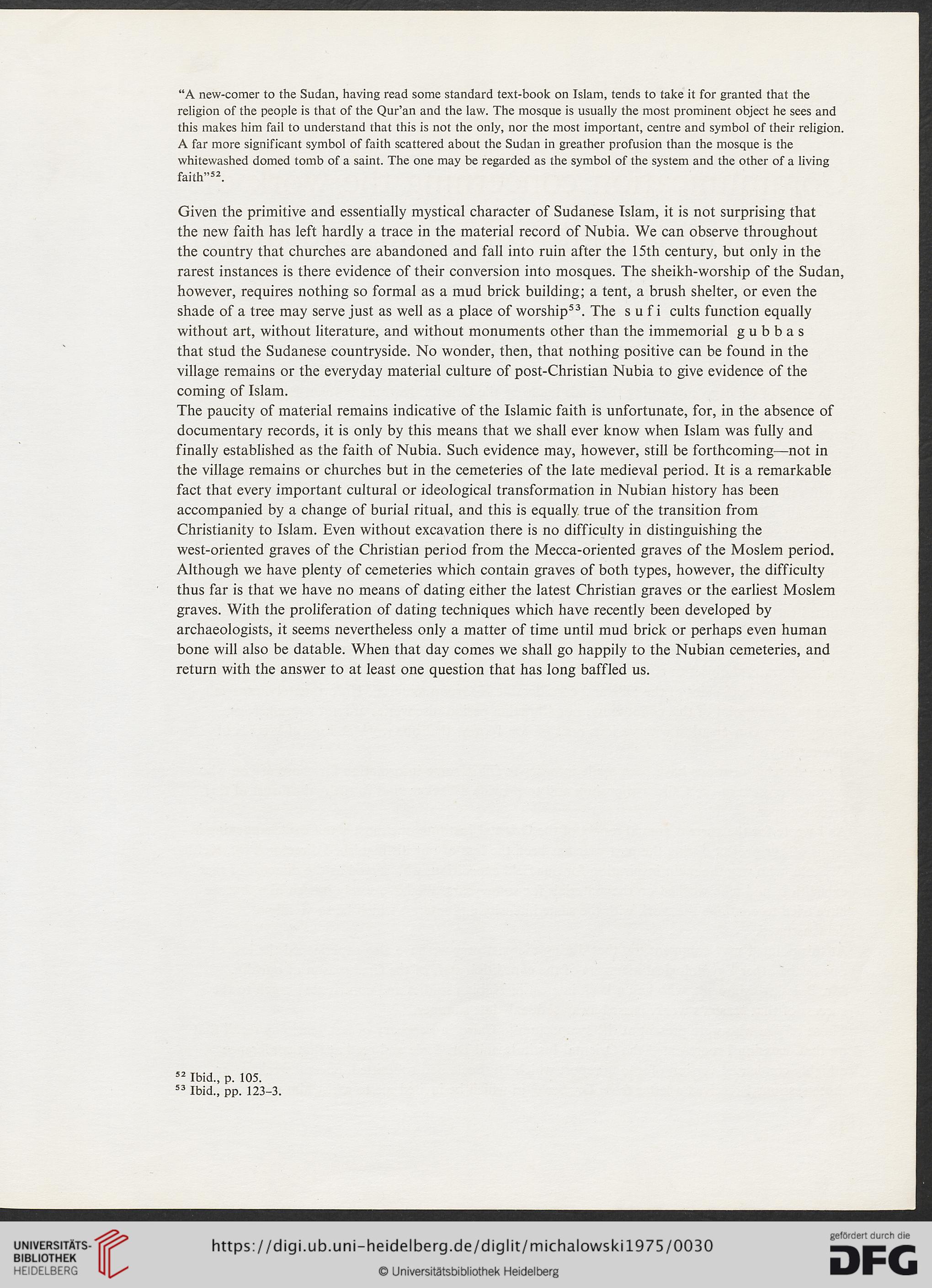“A new-comer to the Sudan, having read some standard text-book on Islam, tends to take it for granted that the
religion of the people is that of the Qur’an and the law. The mosque is usually the most prominent object he sees and
this makes him fail to understand that this is not the only, nor the most important, centre and symbol of their religion.
A far more significant symbol of faith scattered about the Sudan in greather profusion than the mosque is the
whitewashed domed tomb of a saint. The one may be regarded as the symbol of the system and the other of a living
faith”52.
Given the primitive and essentially mystical character of Sudanese Islam, it is not surprising that
the new faith has left hardly a trace in the material record of Nubia. We can observe throughout
the country that churches are abandoned and fall into ruin after the 15th century, but only in the
rarest instances is there evidence of their conversion into mosques. The sheikh-worship of the Sudan,
however, requires nothing so formal as a mud brick building; a tent, a brush shelter, or even the
shade of a tree may serve just as well as a place of worship53. The s u f i cults function equally
without art, without literature, and without monuments other than the immemorial g u b b a s
that stud the Sudanese countryside. No wonder, then, that nothing positive can be found in the
village remains or the everyday material culture of post-Christian Nubia to give evidence of the
coming of Islam.
The paucity of material remains indicative of the Islamic faith is unfortunate, for, in the absence of
documentary records, it is only by this means that we shall ever know when Islam was fully and
finally established as the faith of Nubia. Such evidence may, however, still be forthcoming—not in
the village remains or churches but in the cemeteries of the late medieval period. It is a remarkable
fact that every important cultural or ideological transformation in Nubian history has been
accompanied by a change of burial ritual, and this is equally true of the transition from
Christianity to Islam. Even without excavation there is no difficulty in distinguishing the
west-oriented graves of the Christian period from the Mecca-oriented graves of the Moslem period.
Although we have plenty of cemeteries which contain graves of both types, however, the difficulty
thus far is that we have no means of dating either the latest Christian graves or the earliest Moslem
graves. With the proliferation of dating techniques which have recently been developed by
archaeologists, it seems nevertheless only a matter of time until mud brick or perhaps even human
bone will also be datable. When that day comes we shall go happily to the Nubian cemeteries, and
return with the answer to at least one question that has long baffled us.
52 Ibid., p. 105.
53 Ibid., pp. 123-3.
religion of the people is that of the Qur’an and the law. The mosque is usually the most prominent object he sees and
this makes him fail to understand that this is not the only, nor the most important, centre and symbol of their religion.
A far more significant symbol of faith scattered about the Sudan in greather profusion than the mosque is the
whitewashed domed tomb of a saint. The one may be regarded as the symbol of the system and the other of a living
faith”52.
Given the primitive and essentially mystical character of Sudanese Islam, it is not surprising that
the new faith has left hardly a trace in the material record of Nubia. We can observe throughout
the country that churches are abandoned and fall into ruin after the 15th century, but only in the
rarest instances is there evidence of their conversion into mosques. The sheikh-worship of the Sudan,
however, requires nothing so formal as a mud brick building; a tent, a brush shelter, or even the
shade of a tree may serve just as well as a place of worship53. The s u f i cults function equally
without art, without literature, and without monuments other than the immemorial g u b b a s
that stud the Sudanese countryside. No wonder, then, that nothing positive can be found in the
village remains or the everyday material culture of post-Christian Nubia to give evidence of the
coming of Islam.
The paucity of material remains indicative of the Islamic faith is unfortunate, for, in the absence of
documentary records, it is only by this means that we shall ever know when Islam was fully and
finally established as the faith of Nubia. Such evidence may, however, still be forthcoming—not in
the village remains or churches but in the cemeteries of the late medieval period. It is a remarkable
fact that every important cultural or ideological transformation in Nubian history has been
accompanied by a change of burial ritual, and this is equally true of the transition from
Christianity to Islam. Even without excavation there is no difficulty in distinguishing the
west-oriented graves of the Christian period from the Mecca-oriented graves of the Moslem period.
Although we have plenty of cemeteries which contain graves of both types, however, the difficulty
thus far is that we have no means of dating either the latest Christian graves or the earliest Moslem
graves. With the proliferation of dating techniques which have recently been developed by
archaeologists, it seems nevertheless only a matter of time until mud brick or perhaps even human
bone will also be datable. When that day comes we shall go happily to the Nubian cemeteries, and
return with the answer to at least one question that has long baffled us.
52 Ibid., p. 105.
53 Ibid., pp. 123-3.




